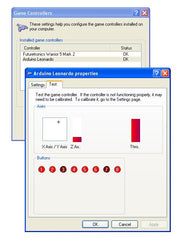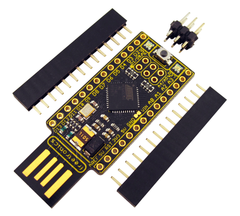Freetronics forum member 'drake250' was wondering if he could emulate a USB joystick using the Freetronics LeoStick - and the answer was Yes. Doing so is very simple when you know how, and he has detailed the procedure which involves changing the HID descriptor code for the LeoStick and some other simple software modifications.
As the member notes - the little Leo' can do it all! So to replicate the joystick yourself, head over to the Freetronics forum for the notes and required files. And we're on twitter, so follow us for news and product updates as well.
To get started with your own embedded-Arduino and USB emulation projects - look no further than the Freetronics LeoStick. Apart from being one of the smallest Arduino-compatibles on the market with USB, it also has an onboard RGB LED and piezo for sound and knock detection:

























